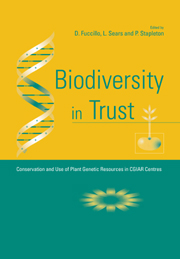Book contents
- Frontmatter
- Contents
- Preface
- Contributors
- Acronyms
- Chapter 1 Cassava
- Chapter 2 The Potato
- Chapter 3 Sweetpotato
- Chapter 4 Other Andean Roots and Tubers
- Chapter 5 Yams
- Chapter 6 Banana and Plantain
- Chapter 7 Cowpea
- Chapter 8 Chickpea
- Chapter 9 Groundnut
- Chapter 10 Lentil
- Chapter 11 Phaseolus Beans
- Chapter 12 Pigeonpea
- Chapter 13 Faba Bean
- Chapter 14 Soyabean
- Chapter 15 Barley
- Chapter 16 Maize, Tripsacum and Teosinte
- Chapter 17 Pearl Millet
- Chapter 18 Small Millets
- Chapter 19 Rice
- Chapter 20 Sorghum
- Chapter 21 Wheat
- Chapter 22 Forages
- Index
Chapter 4 - Other Andean Roots and Tubers
Published online by Cambridge University Press: 22 September 2009
- Frontmatter
- Contents
- Preface
- Contributors
- Acronyms
- Chapter 1 Cassava
- Chapter 2 The Potato
- Chapter 3 Sweetpotato
- Chapter 4 Other Andean Roots and Tubers
- Chapter 5 Yams
- Chapter 6 Banana and Plantain
- Chapter 7 Cowpea
- Chapter 8 Chickpea
- Chapter 9 Groundnut
- Chapter 10 Lentil
- Chapter 11 Phaseolus Beans
- Chapter 12 Pigeonpea
- Chapter 13 Faba Bean
- Chapter 14 Soyabean
- Chapter 15 Barley
- Chapter 16 Maize, Tripsacum and Teosinte
- Chapter 17 Pearl Millet
- Chapter 18 Small Millets
- Chapter 19 Rice
- Chapter 20 Sorghum
- Chapter 21 Wheat
- Chapter 22 Forages
- Index
Summary
There are nine species of other Andean root and tuber crops (ARTC). These crops are adapted to three different agro-ecological conditions of the Andes. First is the warm Andean valley, where five species that produce edible roots or rhizomes are cultivated: arracacha, achira, yacón, mauka and ahipa. Second are the temperate Andean valleys, where the tuber crops ulluco, oca and mashua are grown associated with Andean potatoes. Third are the Andean highlands, where a root-hypocotyl crop called maca is grown because of its frost tolerance.
The ARTC are classified in different taxonomic families, and are therefore totally different crops (Table 4.1). They also differ in their underground edible part, agro-ecology, storage behaviour, propagation, adaptation, use and economic potential. Andean farmers use these crops for food in different ways. Crops such as yacón and ahipa are eaten raw, whereas others have to be cooked. Most of them store starch, but yacón stores sugar.
The tuber crops oca, ulluco and mashua share the same Andean ecological niches of cultivated potatoes and have a high degree of phenotypic diversity, especially in their tubers. They are grown from 2500 to 4000 m asl from the Andes of Venezuela to northwestern Argentina, with the highest cultivation frequency from 3000 to 3900 m from central Peru to central Bolivia (Arbizu and Robles 1986; King 1988; Franco et al. 1989; Tapia et al. 1996). Small plots of these crops are grown up to 4200 m in the central highlands of Peru.
- Type
- Chapter
- Information
- Biodiversity in TrustConservation and Use of Plant Genetic Resources in CGIAR Centres, pp. 39 - 56Publisher: Cambridge University PressPrint publication year: 1997
- 4
- Cited by

